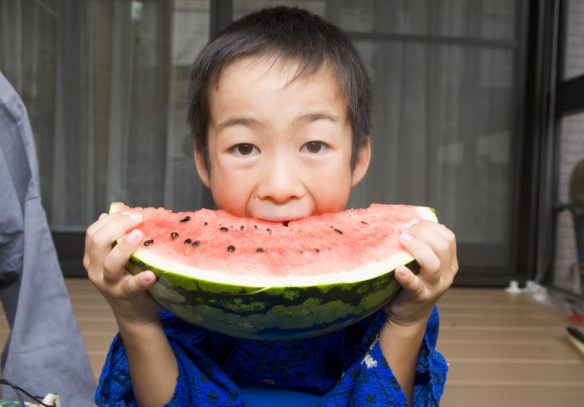While on summer break, you’d think that kids would be more active riding bikes around the neighborhood, jumping off the high dive, playing baseball and burning through all the calories they eat.

However, the opposite can be true: several studies and surveys have found that most kids are actually less active during the summer months compared to the school year. Children are falling short of the recommended 60 minutes of activity day each day. Why? Part of this may be due to “screen time” which increases by about 30 percent during the summer. Diets are also less structured and despite the increase in fresh summer produce, most kids aren’t eating enough of it.
Don’t let your kids take a vacation from healthy habits this summer. Aramark K-12 Registered Dietitian Jennifer Stringfellow offers seven strategies to help keep them on track.
1. Make summer’s perfect produce the centerpiece of your meals. Visit a farmers’ market or a U-Pick berry farm with your children and together prepare meals using fresh, wholesome ingredients. Better yet, give your child a section of the yard to plant his or her own vegetables. Let them harvest and enjoy the fruits of their labor. One easy and fun idea? Cut larger fruits such as melons and pineapple into fun shapes using cookie cutters.
2. Create healthy summer routines. To keep their diets on track, stick with regular meal and snack times, limit after dinner snacks and make sure your kids get enough sleep.
3. Plan outings or vacations that promote physical activity not just R&R. If you’re taking a family vacation, seek out opportunities that keep the whole family active. State and national parks are great for hiking and cycling, and keep plenty of toys on hand, like balls, skateboards and Frisbees, to keep kids active.

4. Look for an organized sports camp or clinic. Most communities offer some type of youth sports programs, from swimming and soccer to baseball and tennis. Get a pass to your local public pool and check out local parks for trails and playgrounds (especially ones with shade trees). Dust off the bike, and break out the roller skates.
5. Stock up on healthy snacks. Keep easy, healthy snacks like fresh fruit, cut-up veggies, yogurt and cheese readily available so kids will choose nutrient-rich between-meal bites.
6. Screens time is idle time. Try to limit “screen” time to no more than one to two hours a day…including both small screens (smart phones and iPads) and large screens (TV).
7. Keep ‘em hydrated. To keep kids hydrated in the heat, give them plenty of water and water-rich fruit like watermelon instead of sweetened soda, fruit drinks or lemonade. Another fun idea? Add diced fruit or berries to water so your kids can shake up some “confetti water” for extra flavor. Or go beyond the water itself by upping the cool factor of their water bottles by letting your kids decorate their own cups or water bottles to encourage frequent hydration.
Note: Since everyone’s health history and nutritional needs are so different, please make sure that you talk with your doctor and a registered dietitian to get advice about the diet and exercise plan that‘s right for you.
Note: Since everyone’s health history and nutritional needs are so different, please make sure that you talk with your doctor and a registered dietitian to get advice about the diet and exercise plan that‘s right for you.

